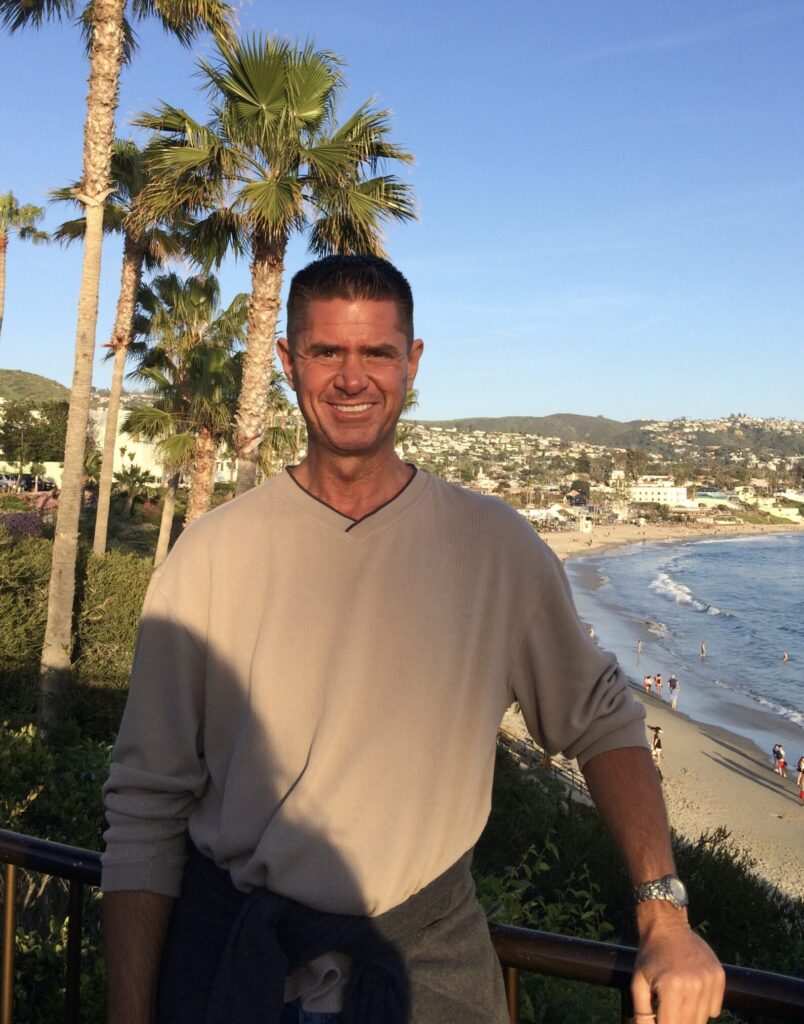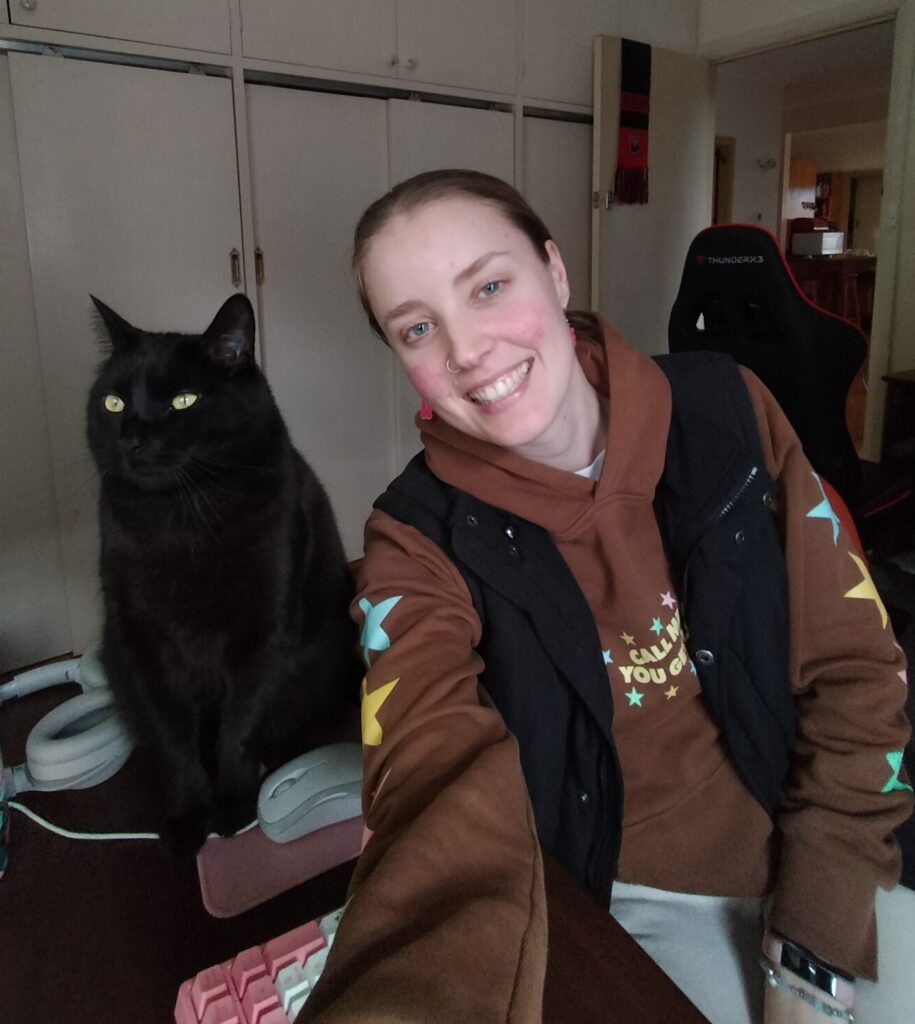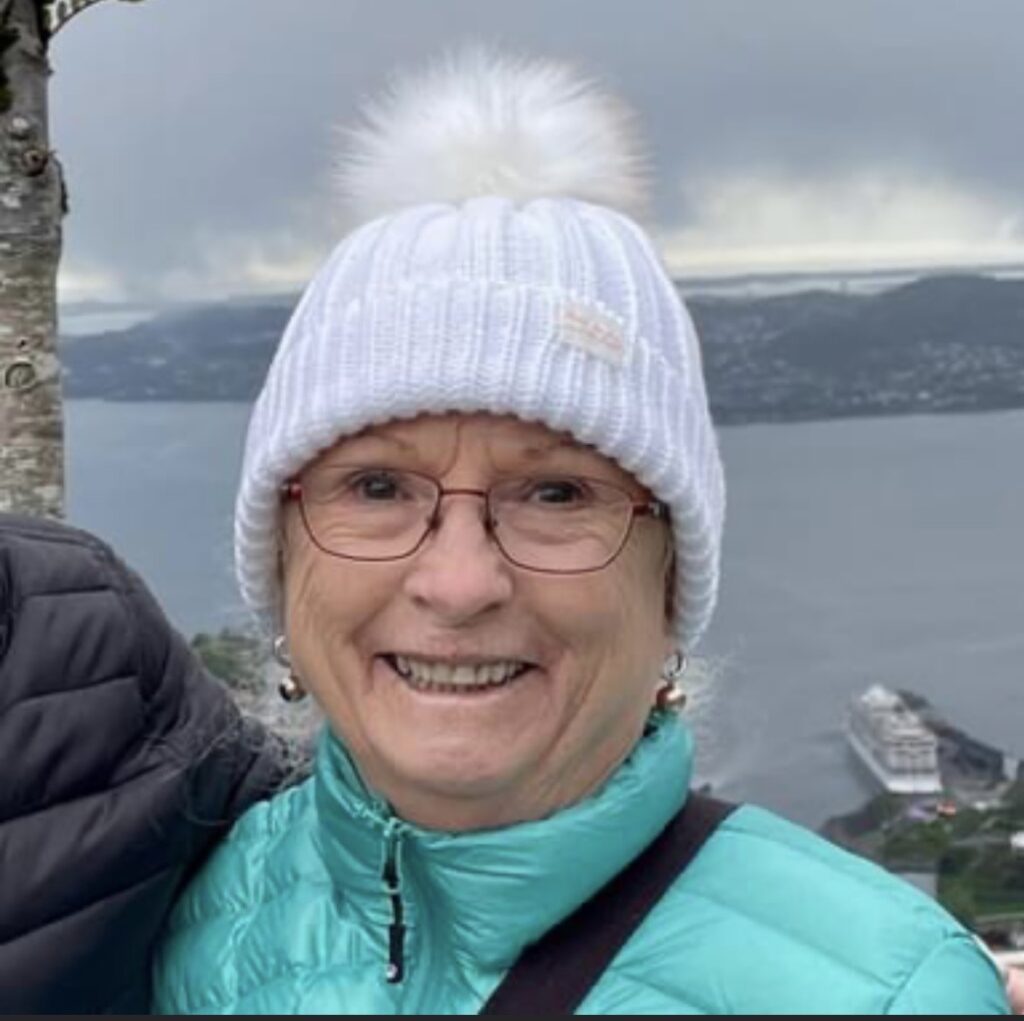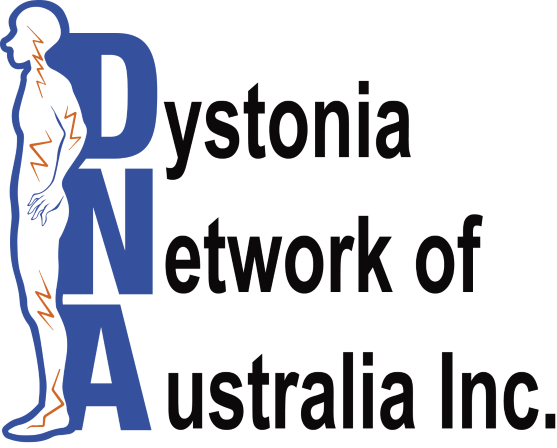On this page:
- 5 Minutes with life coach, author and dystonia advocate Tom Seaman
- 5 Minutes with dystonia researcher Jordan Morrison-Ham
- 5 Minutes with clinical trial participant Chris Gavenlock

5 minutes with Tom Seaman
Tom Seaman is a Life Coach in the area of health and wellness, and the author of 2 books, Diagnosis Dystonia: Navigating the Journey and Beyond Pain and Suffering: Adapting to Adversity and Life Challenges. He is also a speaker, chronic pain and dystonia awareness advocate, health blogger, volunteer for the Dystonia Medical Research Foundation (DMRF) as a support group leader, and is a member and volunteer writer for Chronic Illness Bloggers Network, The Mighty, Brain & Life Magazine, and Patient Worthy. To learn more about Tom, his books and coaching practice, visit www.TomSeaman.com. Follow him on Twitter @Dystoniabook1 and Instagram @CoachTom12.
Tom what was life like before you developed dystonia?
I was a very competitive athlete, involved in several businesses, active with my family and friends, and at the time of onset, I was attending graduate school for my degree in counseling with many exciting plans for the future.
Tell us about the ways dystonia has had an impact on you.
In the very beginning, the muscle contractions were so severe and the pain was off the charts that I literally lived on my floor rolling around all day. I became very isolated, lost all of my money, and was too disabled to work. I was 30 at the time in the prime of my life but felt hopeless and helpless so I began experiencing anxiety and depression. I also became morbidly obese from a very unhealthy lifestyle.
After about 5 years, I found different ways to better manage my symptoms which gave me hope. I also lost the 150 pounds (68 kilos) I had gained. I then began to write books and articles and it helped people in ways I never expected.
In the beginning, I felt I had lost everything. As time moved on, I realized that dystonia taught me many valuable lessons such as gratitude, strength, courage, perseverance, humility, and compassion. I also learned that I could use my pain and suffering to help others, so in many ways, dystonia has given my life more meaning and purpose.
You’re a certified life coach and active Dystonia advocate. How did that come about?
When I began to get my symptoms under better control in 2007, I was asked by a national organization to share my story in their quarterly magazine. To my surprise, I was contacted by many people who read the story and were looking for guidance. I found myself on the helping end, emailing and talking to people all day trying to provide support. I then started a support group to connect with people even more. Someone suggested that I become a life coach. I investigated it and thought it would be a good path for me to pursue because I am really passionate about helping others.
What are the things you wish you’d known in the early days of your dystonia?
I wish I knew how many treatment options were available and that this condition did not mean a life sentence of pain and misery; that I could again find joy in my life. I also wish someone helped me understand the emotional suffering I was going through so I had better perspective. While the physical pain was extremely difficult to handle, grief about the life I once had was also very prominent, but rarely addressed. Basically, I needed someone to give me encouragement and reassurance that if I keep hope alive and not give up that I could live a meaningful life. I needed someone who had “been there, done that” to let me know everything would be okay. This is one of the main motivating factors for the writing and coaching I do today.
What do you like to do in your spare time?
Being out in nature. I love to tinker around in my garden, take walks, watch the sunset, photography, take care of my plants, spend time near water, and I like to be as active as I possibly can with different forms of exercise within my range of ability. I also enjoy writing (poetry in addition to health topics), so I keep my blog active and write articles for different magazines. All of it is volunteer work which makes me feel good to pay forward the many things I have been given along the way to help me get to where I am today.
What’s something you’ve done that really took you out of your comfort zone?
About 15 years ago I was dealing with severe anxiety and panic attacks. One of the worst triggers for me was driving, especially over bridges. I went 10 years without going down one particular road because of a bridge that terrified me. One day I said to myself, “I can’t keep living like this. It’s self-imprisonment.” I forced myself to go over the bridge and I did it again and again and again. It was incredibly scary at first, but the more I did it the better I felt. In just a couple of weeks, I conquered my fear of bridges, and driving in general, which has increased my boundaries where I can now travel anywhere without fear.
What’s something you’re looking forward to and why?
I’m really looking forward to writing my third book when I find time. I love the creative process and I think the topics I have upcoming will really resonate with people within and outside the dystonia community.
You’ve written books and blogs, done videos and spoken at conferences, so many people know a lot about you. Can you tell us something about Tom Seaman that people would never guess?
I make my own greeting cards with personalized poems. I haven’t purchased a greeting card from the store since probably the 90’s. I also have 70 plants… and that’s just on the inside of my home!

When did you begin your academic journey and what areas of study have you explored?
I began my academic journey studying photography of all things! I received a diploma in photoimaging, and after some time off, decided to go back to school to study psychology. I did both my Bachelor’s and Honours degrees in Psychological Science at Deakin University, and am now finishing up my PhD in neuroscience at Deakin too.
What are you currently researching and what/who inspired you to become involved in this research project?
I’m currently running a clinical trial looking at non-invasive brain stimulation, and whether this could be a new treatment for cervical dystonia. When I decided to pursue a PhD, my supervisor approached me with the idea for the project, and I’ve been interested in dystonia ever since!
What sort of things are involved in running the research project?
A lot of planning, a lot of ethics submissions, and sadly a lot of revising and overcoming obstacles, such as technology deciding it won’t work! Liaising with other interested parties is also quite important – for example, neurologists and other researchers who help to analyse the data. I also spend a bit of time with my supervisor and our team debriefing over coffee after a long session – especially if something doesn’t go quite to plan, or if there is feedback given to us from a participant. And unsurprisingly, there is a lot of answering/sending emails!
What do you hope to achieve with the research project?
Although the main outcome of the project is to determine whether we can use non-invasive brain stimulation as a treatment option, overall, I’d love to spread the word about dystonia and what it is to the general public. Much of the feedback we have received from participants has been that so many people don’t know what dystonia is, including their medical professionals – even I had no idea what it was until I started my project. So I’d love to continue raising awareness whilst trying to find new treatments for dystonia.
Where do you hope your academic career will lead you?
I’d love to continue in the research field – whether that’s running other clinical trials or continuing to work with people with dystonia.
You’re teaching at Deakin University, doing the research trial and completing your PhD – do you have any downtime? How do you find a balance between your work and life outside work?
When I first started my PhD I made a promise with myself to never work on a weekend unless it was desperately needed – and I think that has helped a lot with making sure I have downtime to relax, spend time with my family (and cats!), and take a brain break. I also try not to do too much extra work at home once I’ve left the office for the day. I think this helps with separating my work life and home life, so I can fully relax and become a couch potato once home!
What other things interest you?
I’m a big foodie – I love cooking and trying new foods and cuisines. I also enjoy going out on hikes and spending time in the garden.
Favourite food?
Anything Japanese. If I had to pick one dish it would be tempura vegetables with soba noodles.
What would be your ideal way to spend a weekend?
At the beach, or on the couch with some good food, my cats, and a movie.
Thank you very much Jordan!

5 minutes with Chris Gavenlock
Chris Gavenlock has been a member and supporter of DNA since its inception. Chris trained as a nurse and has been employed in different areas of nursing. She is a complete livewire who exhausts other people with her energy, enthusiasm, and involvement in many causes and areas of life.
Chris, how long have you had dystonia?
My symptoms first began in late 1983 so it’s been 40 years now. In the 11 years between when I first developed symptoms and when I was eventually diagnosed in 1994, I was continually trying to find an answer to why my hand was not doing what I was asking it to do. I saw many doctors and tried countless therapies to no avail.
Can you tell us about the type of dystonia you have?
I have focal hand dystonia and it affects my right hand. Whenever I try to use my hand for anything, my fingers start clenching towards and digging into my palm and my wrist rolls inwards bringing my hand towards my forearm. I know what my brain is telling my hand to do but my hand seems to ignore my brain and has a will of its own. I can sometimes stop the movements by holding onto something, touching something, folding my arms, etc.
The biggest issue and most noticeable problem is writing and other fine coordinated movements. Over the years, I’ve developed different ways of doing things and using other parts of my body, not normally involved, to assist. Holding a pen in a bizarre manner with my hand and using my upper arm and shoulder has been the only way that I could write legibly.
This has resulted in increased pain and my upper arm, shoulder and neck have been affected as well as my hand.
What impact does dystonia have on your life?
I’m predominately right-handed and not very dextrous with my left hand so there are not many things my dystonia does not affect. Making the bed, washing my face, cleaning my teeth, getting dressed, making a cup of coffee, getting my breakfast, cooking, driving a manual car, etc. Over the years I adapted how I would hold items and carry out tasks using my hand/arm/shoulder – in quite weird postures at times.
Working was difficult and I had to take sick leave, annual leave and long service leave in order to recoup my strength for the daily struggle of performing day to day activities that were so simple for others and so difficult and energy draining for me. I would neglect all but absolutely essential documentation and use either an electric typewriter or computer to maintain records and I had to take regular breaks.
I eventually had to retire from my nursing career in 1997 because of dystonia. At that time I was working in Occupational Health and Workplace Rehabilitation.
What was your journey to diagnosis like?
In 1994 I suggested to my GP that my condition may have a neurological cause. My GP referred me to a neurologist who said that he was fairly sure what my condition was but needed to do some testing to eliminate any other conditions before committing to a diagnosis.
After extensive neurological investigations the diagnosis was – DYSTONIA!!!!!
What a relief to find that someone knew exactly what I was talking about when I described my symptoms and what happened when I attempted to use my right hand/arm. Finally with a diagnosis, and the internet, I was able to do some research. I discovered the Dystonia Medical Research Foundation (DMRF) and found that I was not alone.
My workplace referred me to numerous doctors for opinions on how I could ‘get better’ and work without medical restrictions even though I had dystonia! One doctor suggested that I ‘relax musculature of shoulder girdle and cervical spine’ and increase exercise – regular exercising against progressively increasing resistance with high repetitions and a daily swimming program in a heated pool. It was also suggested that I place a rubber band around the ends of my righthand fingers and thumb and open and close my hand against the resistance of the rubber band whenever possible during the day to strengthen the muscles in my right hand. But I was aware that increased activity exacerbated my condition so I didn’t follow this advice – besides, in regard to the suggested swimming regime, I’d probably drown if I attempted to swim!
Now that I had more time on my hands I continued to research dystonia. It was from the DMRF that I found the International On Line Dystonia Support Group
In March 1996 David Barton from New Zealand came up with the idea of a Dystonia On Line Support Group. Larry Craig from Montreal, Canada and Anne Brett from Texas joined in to assist in the formation of this group. Every Wednesday the group met for chats on the Undernet. This was an international group that continued to grow with people coming together from all over the world. It was such a benefit to find, and talk, with others who knew what it was like living with this weird condition.
You’re an avid traveller. Has your dystonia caused any issues with travel?
The main issue for me when travelling was filling out forms and prior to being able to ‘tap’ credit cards, a huge issue was having to sign for things. My signature was always being challenged! Luckily my husband has attended to anything he knows that I can’t manage.
Tell us about your recent medical intervention?
I’m participating in Dr Joel Maamary’s interventional study using MRgFUS for focal hand dystonia at St Vincent’s in Sydney. I was admitted on the 1st August 2023 for an MRI and neurophysiological testing. I had the MRgFUS procedure the next day and went home the day after that. The following day I returned to Sydney to stay the night and the next day I flew to Thailand!
Immediately after the procedure, I could write and type much better and estimate that there was a 70% improvement in my dystonia. I went back to St Vincent’s on 5th September for an MRI and about 3 hours of testing with Dr Joel who is just as pleased as I am with my progress. I had no side effects aside from being a little unsteady in the ocean on one day when we were in Thailand.
It’s early days and we don’t know the long-term effect that the MRgFUS procedure will have on my dystonia. Participants in this trial commit to return to St Vincent’s at 1 month, 3 month, 6 month and 12 month intervals for MRIs and testing. This procedure is not a cure but, from my perspective, it is certainly looking very promising as a treatment for dystonia. More information about this study can be found here.
Besides travel, what are some of your other interests?
Family and friends, seeing new places and meeting new people. And I’m a consultant for Nutrimetics Skin Care. I help to preserve the history of Morisset Hospital, our local historic mental health facility, where I worked during my nursing career. I’m also involved with Dora Creek School of Arts Inc., which has provided a community hall, solely owned and maintained by the residents of Dora Creek, since 1918. Our hall has regular hirers every day except Saturday and we have a Friday morning Op Shop to raise money to maintain the hall for community use.
Tell us something that few people know about you.
The only thing that brings me to tears with my dystonia is when I’m brushing my teeth and my hand does its ‘thing’ and manages to snap a toothbrush in two. I’m sure I couldn’t do that myself using both hands!
Thank you very much Chris!
Page updated 23 September 2023



